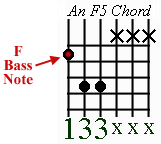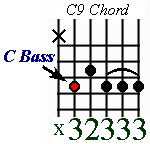
Other Numbered Chords
Chords are the basis of all Western music. They are absolutely crucial to the guitar and to rock music, and an understanding of chords will improve your understanding of the guitar and music immensely. This page is designed to help you with the music theory behind numbered chords like B9 , G6, or D5, which confuse a lot of people. So I hope this is helpful to all you beginners out there. Before you read this, you should be familiar with the theory of major and minor chords and seventh chords.
Five Chords (D5)
Five chords are simple--they contain a root and a fifth. They follow the pattern 1-5. So a D5 contains D and A, the root and fifth. An A5 contains A and E, as shown here:

These chords are most often played as power chords, which have the general appearance 133xxx or x133xx. The lowest note played is the root note, so the root note of the chord 133xxx appears on the sixth string, and the root note of the chord x133xx appears on the fifth string. That means that 133xxx is an F5 and x133xx is a Bb5. The general appearance of a 5 chord is shown here:


To create your own 5 chords, first figure out what the root note is. As an example, in the case of B5 the root note is B. Then, find out where that note is on the fretboard. The diagram above shows the notes present on the 5th and 6th strings on your guitar. In the case of B, you can find it on the fifth string 2nd fret. Now, build the 5 chord shape on top of the root note, and you get x244xx, a B5 chord.
Six Chords (G6)
Sixth chords are similar to major or minor chords because they contain a root, third, and fifth. In addition, sixth chords contain a sixth. Therefore, a sixth chord contains a root, third, and sixth; and follows the pattern 1-3-5-6. A common example of a sixth chord is a G6, which contains G, B, D, and E and is played 3x2003. Another sixth chord is A6, which is contains A, C#, E, and F#; and is played x02222:

There aren't a lot of common sixth chords, so when you see one, check the music to see how it is formed.
Nine Chords (B9)
Nine chords are fairly common in music. They contain five different notes: a root, third, fifth, seventh, and ninth; and follow the pattern 1-3-5-m7-9. Therefore, an E9 contains E, G#, B, D, and F#; as shown here:

Nine chords are formed one way, as shown below. This is a C9 chord. If you can barre the three high strings with your ring or pinkie finger, then do it. Otherwise, you can sometimes forget the first string, but that note is important so you really want to play it.

Note that the C bass is located on the fifth string, so it can be moved just like a barre chord. G9 can also be played 3x3230.
Remember that a C9 and a Cadd9 are not the same. A C9 contains the root, third, fifth, seventh, and ninth, while a Cadd9 contains only the root, third, fifth, and ninth (no seventh, 1-3-5-9). C9 is played x32333 while Cadd9 is played x32033 or x32030. For more information, see my page on chords with added notes.
That does it for numbered chords. You can add some really crazy numbers like 11 or 13 (which is done in jazz a lot), but these are really unimportant for most music you will be playing. I hope this has been useful. Good luck, have fun, and keep playin' !
Back to Dansm's Guitar Chord Theory
You are visitor number
© 1997 Daniel E. Smith.